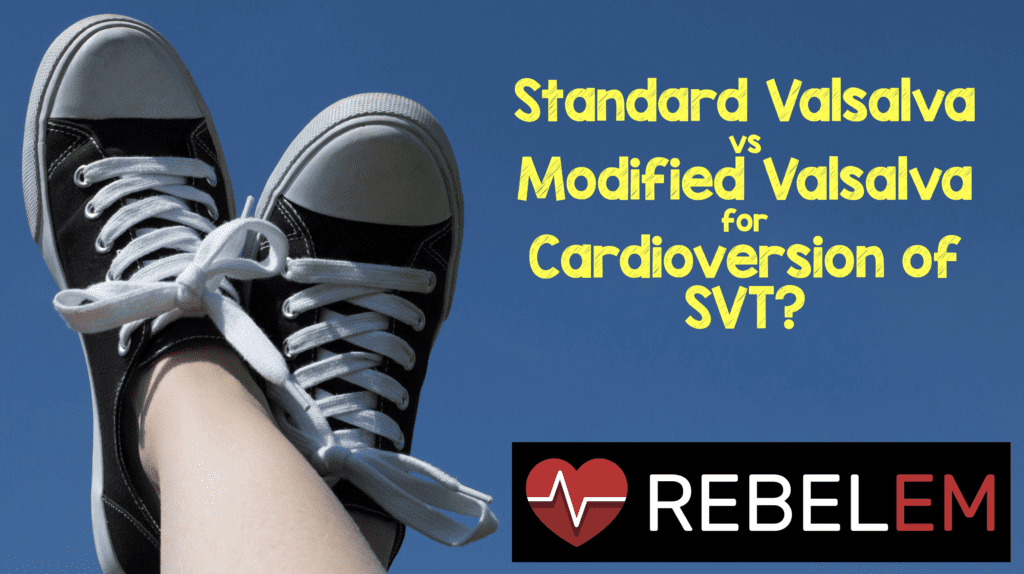

What They Did: The authors conducted a randomized, multicenter parallel group trial in five emergency departments in China. Patients were randomized in a 1:1 fashion to the treatment group or control group.
- Inclusion Criteria: adult patients age 18-70 presenting with SVT confirmed by 12 lead ECG [regular, narrow complex (QRS < 120 ms), rate > 100 bpm.
- Exclusion Criteria: hemodynamic instability requiring electrocardioversion, known history of aortic stenosis, recent MI, glaucoma, or retinopathy. Also excluded were patients judged to be in sinus tachycardia, atrial fibrillation or atrial flutter.
- Control Group: Performed “strain” by blowing into a 10ml syringe, attempting to move the plunger, for 15 seconds. “Strain” performed in sitting position for up to three attempts if cardiac monitor continued to show SVT.
- Treatment Group: “Strain” performed same as control group. Immediately, the patient was laid flat on a flat bed with their legs raised at 90 degrees for 15 seconds. This was repeated up to three times if the patient remained in SVT.
Outcomes:
- Primary Outcome: Conversion to sinus rhythm after the Valsalva maneuver, as confirmed by ECG
- Secondary Outcomes:
- Use of medications
- Electrocardioversion
- Need for hospital admission
- ED LOS
- Adverse events
Results: During the 2-year study period, 238 patients were enrolled, half (119) were placed into each group (control vs treatment).
- In the modified Valsalva group, the proportion of patients requiring drug treatment or electro-cardioversion was lower than that of the control group (51% vs 84%).
- Conversion to sinus rhythm 60 seconds after Valsalva: 16% control vs 46% treatment [OR 3.82 (95% CI 2.5-5.9)]. This results in a NNT of 3.3.
- Accordingly, there was less medication use in the treatment group (45%) than the control group (71%) [OR 0.50 (95% CI 0.33-0.69)].
- No statistical difference was seen in adverse events or ED LOS
Strengths:
- Multicenter randomized trial
- Easily reproducible intervention
- Meaningful outcomes selected
- ECG performed whether there was conversion to sinus rhythm or no conversion to confirm patient’s rhythm at the end of the procedure
Limitations:
- Single country with large population
- Only 238 cases
- No power calculation
- Although listed in the outcomes, there is no mention of electrocardioversion use or need for hospital admission in the results/discussion
- Unclear at what time point the patients were considered to have a success or failure of cardioversion
- Also uncertainty regarding the amount of effort patient put into blowing into the syringe, as this may likely have a profound effect on the results
Discussion:
- Treatment of SVT has many different options. Vagal maneuvers are still considered first line therapy. The most commonly used vagal maneuver is the Valsalva maneuver, which has historically had a very poor success rate. The next choice is often adenosine, but patients often find this an uncomfortable therapy. Some patients will even avoid coming to the ED in SVT for fear of receiving adenosine. Ideally, a vagal maneuver, with greatly increased success, would be employed to avoid medications and their potential side effects.
- The type of SVT also plays a role here. SVT with a short RP interval (AVNRT, AVRT) are AV node dependent, and are more likely to respond to vagal maneuvers compared to SVT with a long RP interval (atrial tachycardia/sinus tachycardia/atypical AVNRT), where the AV node is not a tachycardia dependent component. The results of this study support this rationale.
Author Conclusion: “With this simple modified Valsalva maneuver, the conversion rate of SVT to sinus rhythm was higher than the standard Valsalva maneuver.”
Clinical Take Home Point: Use of a 10 mL syringe and lying the patient supine with 90 degrees of hip flexion can be a useful treatment for SVT, with few adverse effects and no change in ED LOS, if the use of medications or electricity is not desired.
References:
- Chaofeng C et al. A Multicenter Randomized Controlled Trial of a Modified Valsalva Maneuver for Cardioversion of Supraventricular Tachycardias. AJEM 2019. PMID: 31422858
- Orejarena LA, Vidaillet H, DeStefano F, et al. Paroxysmal Supraventricular Tachycardia in the General Population. JACC 1998. PMID: 9426034
- Smith G et al. Use of the Valsalva Manoeuvre in the Prehospital Setting: A Review of the Literature. Emerg Med J 2009. PMID: 19104086
- Lim SH et al. Comparison of Treatment of Supraventricular Tachycardia by Valsalva Maneuver and Carotid Sinus Massage. Ann Emerg Med 1998. PMID: 9437338
- Pandya A et al. Valsalva Maneuver for Termination of Supraventricular Tachycardia. Ann Emerg Med 2015. PMID: 23932719
For More Thoughts on This Topic Checkout:
Post Peer Reviewed By: Salim R. Rezaie, MD (Twitter: @srrezaie)
The post Standard Valsalva vs Modified Valsalva for Cardioversion of SVT? appeared first on REBEL EM - Emergency Medicine Blog.
